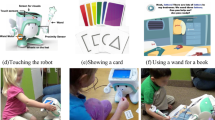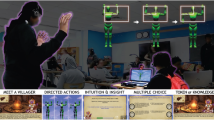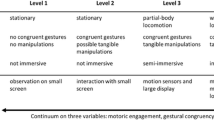Abstract
The purpose of this paper is twofold. We first present a methodological framework for the analysis of embodied interaction with technology captured through video recording. The framework brings together a social semiotic approach to multimodality with the philosophical and theoretical roots of embodied cognition. We then demonstrate the application of the framework by exploring how the computational thinking of two fifth grade learners emerged as an embodied phenomenon during an educational robotics activity. The findings suggest that, for young children, computational thinking was extended to include the structures in the environment and guided by their embodiment of mathematical concepts. Specifically, the participants repeatedly used their bodies to simulate different possibilities for action while incorporating both perceptual and formal multiplicative reasoning strategies to conceptualize the robot’s movements. Implications for the design of embodied educational robotics activities and future application of the methodological framework are discussed.



Similar content being viewed by others
References
Alibali, M.W., Boncoddo, R., Hostetter, A.B. (2014). Gesture in reasoning: an embodied perspective. In The Routledge handbook of embodied cognition (pp. 168-177). Routledge.
Abrahamson, D. (2017). Embodiment and mathematical learning. The SAGE encyclopedia of out-of-school learning. New York: SAGE.
Abrahamson, D., & Lindgren, R. (2014). Embodiment and embodied design. In R.K. Sawyer (Ed.), The Cambridge handbook of the learning sciences (2nd ed.). Cambridge, MA: Cambridge University Press.
Abrahamson, D., & Trninic, D. (2015). Bringing forth mathematical concepts: Signifying sensorimotor enactment in fields of promoted action. ZDM, 47(2), 295–306. https://doi.org/10.1007/s11858-014-0620-0.
Alibali, M. W., Nathan, M. J., Wolfgram, M. S., Church, R. B., Jacobs, S. A., Johnson Martinez, C., et al. (2014). How teachers link ideas in mathematics instruction using speech and gesture: A corpus analysis. Cognition and Instruction, 32(1), 65–100. https://doi.org/10.1080/10508406.2011.611446.
Alibali, M. W., & Nathan, M. J. (2012). Embodiment in mathematics teaching and learning: Evidence from learners' and teachers' gestures. Journal of the Learning Sciences, 21(2), 247–286. https://doi.org/10.1080/10508406.2011.611446.
Atit, K., Weisberg, S. M., Newcombe, N. S., & Shipley, T. F. (2016). Learning to interpret topographic maps: Understanding layered spatial information. Cognitive Research: Principles and Implications, 1(2), 1–18. https://doi.org/10.1186/s41235-016-0002-y.
Atmatzidou, S., & Demetriadis, S. (2016). Advancing students’ computational thinking skills through educational robotics: A study on age and gender relevant differences. Robotics and Autonomous Systems, 75, 661–670. https://doi.org/10.1016/j.robot.2015.10.008.
Baker, W. D., Green, J. L., & Skukauskaite, A. (2008). Video-enabled ethnographic research: A microethnographic perspective. How to do educational ethnography, 76-114.
Barth, H., Baron, A., Spelke, E., & Carey, S. (2009). Children’s multiplicative transformations of discrete and continuous quantities. Journal of Experimental Child Psychology, 103(4), 441–454. https://doi.org/10.1016/j.jecp.2009.01.014.
Baxter, P., & Jack, S. (2008). Qualitative case study methodology: Study design and implementation for novice researchers. The qualitative report, 13(4), 544-559. https://www.nova.edu/ssss/QR/QR13-4/baxter.pdf
Berland, M., & Wilensky, U. (2015). Comparing virtual and physical robotics environments for supporting complex systems and computational thinking. Journal of Science Education and Technology, 24(5), 628–647. https://doi.org/10.1007/s10956-015-9552-x.
Bers, M. U., Flannery, L., Kazakoff, E. R., & Sullivan, A. (2014). Computational thinking and tinkering: Exploration of an early childhood robotics curriculum. Computers & Education, 72, 145–157. https://doi.org/10.1016/j.compedu.2013.10.020.
Bezemer, J. (2014). Multimodal transcription: A case study. Interactions, images and texts: A reader in multimodality, 11, 155–170.
Bezemer, J., & Mavers, D. (2011). Multimodal transcription as academic practice: A social semiotic perspective. International Journal of Social Research Methodology, 14(3), 191–206. https://doi.org/10.1080/13645579.2011.563616.
Blikstad-Balas, M. (2017). Key challenges of using video when investigating social practices in education: Contextualization, magnification, and representation. International Journal of Research & Method in Education, 40(5), 511–523. https://doi.org/10.1080/1743727X.2016.1181162.
Boyer, T. W., & Levine, S. C. (2015). Prompting children to reason proportionally: Processing discrete units as continuous amounts. Developmental Psychology, 51(5), 615. https://doi.org/10.1037/a0039010.
Brennan, K., & Resnick, M. (2012). New frameworks for studying and assessing the development of computational thinking. Paper presented in the proceedings of the 2012 annual meeting of the American Educational Research Association, Canada, Vancouver.
Calvo, P., & Gomila, T. (Eds.). (2008). Handbook of cognitive science: An embodied approach. Amsterdam: Elsevier.
Chemero, A. (2009). Radical embodied cognition. Cambridge, MA: MIT Press.
Chen, G., Shen, J., Barth-Cohen, L., Jiang, S., Huang, X., & Eltoukhy, M. (2017). Assessing elementary students’ computational thinking in everyday reasoning and robotics programming. Computers & Education, 109, 162–175. https://doi.org/10.1016/j.compedu.2017.03.001.
Dreyfus, H. L. (1996). The current relevance of Merleau-Ponty’s phenomenology of embodiment. The Electronic Journal of Analytic Philosophy, 4(4), 1–16.
Duijzer, C. A., Shayan, S., Bakker, A., Van der Schaaf, M. F., & Abrahamson, D. (2017). Touchscreen tablets: Coordinating action and perception for mathematical cognition. Frontiers in Psychology, 8, 144. https://doi.org/10.3389/fpsyg.2017.00144.
Favela, L. H., & Chemero, A. (2016). The animal-environment system. In Y. Coelllo & M. H. Fischer (Eds.), Foundations of embodied cognition: Perceptual and emotional embodiment (Vol. 1, pp. 59–74). New York: Routledge.
Ferrara, F. (2014). How multimodality works in mathematical activity: Young children graphing motion. International Journal of Science and Mathematics Education, 12(4), 917–939. https://doi.org/10.1007/s10763-013-9438-4.
Flood, V.J., & Abrahamson, D. (2015). Refining mathematical meanings through multimodal revoicing interactions: The case of ‘‘faster’’. In Annual Meeting of the American Educational Research Association, Chicago, April (pp. 16-20).
Flood, V. J., Harrer, B. W., & Abrahamson, D. (2016). The interactional work of configuring a mathematical object in a technology-enabled embodied learning environment. Singapore: International Society of the Learning Sciences.
Gallese, V., & Lakoff, G. (2005). The brain’s concepts: The role of the sensory-motor system in conceptual knowledge. Cognitive Neuropsychology, 22(3–4), 455–479. https://doi.org/10.1080/02643290442000310.
Garcez, P. M. (1997). Microethnography. In Encyclopedia of language and education (pp. 187-196). Springer, Dordrecht.
Gibson, J.J. (1977). The theory of affordances. In R. E. Shaw & J. Bransford (Eds.), Perceiving, Acting, and Knowing. Hillsdale, NJ: Lawrence Erlbaum Associates.
Gibson, J.J. (1986). The ecological approach to visual perception. New York, NY: Taylor & Francis Group. (Original work published in 1979).
Glenberg, A. M., & Kaschak, M. P. (2002). Grounding language in action. Psychonomic Bulletin & Review, 9(3), 558–565. https://doi.org/10.3758/BF03196313.
Goffman, E. (1964). The neglected situation. American Anthropologist, 66(6), 133–136.
Goodwin, M. H. (2007). Participation and embodied action in preadolescent girls' assessment activity. Research on Language and Social Interaction, 40(4), 353–375. https://doi.org/10.1080/08351810701471344.
Gordon, C. L., Shea, T. M., Noelle, D. C., & Balasubramaniam, R. (2019). Affordance compatibility effect for word learning in virtual reality. Cognitive Science, 43(6), 1–17.
Grover, S., & Pea, R. (2013). Computational thinking in K–12: A review of the state of the field. Educational Researcher, 42(1), 38–43. https://doi.org/10.3102/0013189X12463051.
Hall, R., & Nemirovsky, R. (2012). Introduction to the special issue: Modalities of body engagement in mathematical activity and learning. Journal of the Learning Sciences, 21(2), 207–215. https://doi.org/10.1080/10508406.2011.611447.
Harlow, D. B., Dwyer, H. A., Hansen, A. K., Iveland, A. O., & Franklin, D. M. (2018). Ecological design-based research for computer science education: Affordances and effectivities for elementary school students. Cognition and Instruction, 36(3), 224–246. https://doi.org/10.1080/07370008.2018.1475390.
Hirose, N. (2002). An ecological approach to embodiment and cognition. Cognitive Systems Research, 3(3), 289–299. https://doi.org/10.1016/S1389-0417(02)00044-X.
Hostetter, A. B., & Alibali, M. W. (2008). Visible embodiment: Gestures as simulated action. Psychonomic Bulletin & Review, 15(3), 495–514. https://doi.org/10.3758/PBR.15.3.495.
Howison, M., Trninic, D., Reinholz, D., Abrahamson, D. (2011). The Mathematical Imagery Trainer: From embodied interaction to conceptual learning. In Proceedings of the SIGCHI Conference on Human Factors in Computing Systems (pp. 1989-1998).
Hutchins, E. (1995). Cognition in the Wild. MIT press
Hutchins, E., & Nomura, S. (2011). Collaborative construction of multimodal utterances. In J. Streeck, C. Goodwin, C. LeBaron (Eds.) Embodied interaction: Language and body in the material world, p. 29-43. Cambridge Press.
Jaspers, J. (2013). Interactional sociolinguistics and discourse analysis. In The Routledge handbook of discourse analysis(pp. 161-172). Routledge.
Jeong, Y., Levine, S. C., & Huttenlocher, J. (2007). The development of proportional reasoning: Effect of continuous versus discrete quantities. Journal of Cognition and Development, 8(2), 237–256. https://doi.org/10.1080/15248370701202471.
Jewitt, C., Bezemer, J., & O'Halloran, K. (2016). Introducing multimodality. Routledge.
Johnson-Glenberg, M. C., & Megowan-Romanowicz, C. (2017). Embodied science and mixed reality: How gesture and motion capture affect physics education. Cognitive Research: Principles and Implications, 2(1), 24. https://doi.org/10.1186/s41235-017-0060-9.
Kong, S.C., Abelson, H., Lai, M. (2019). Introduction to Computational Thinking Education. In Computational Thinking Education (pp. 1-10). Springer, Singapore.
Kopcha, T. J., McGregor, J., Shin, S., Qian, Y., Choi, J., Hill, R., et al. (2017). Developing an integrative STEM curriculum for robotics education through Educational Design Research. Journal of Formative Design in Learning, 1(1), 31–44. https://doi.org/10.1007/s41686-017-0005-1.
Kopcha, T., & Ocak, C. (2019). Embodiment of computational thinking during collaborative robotics activity. In Proceedings of Computer Supported Collaborative Learning, International Society of the Learning Sciences. https://repository.isls.org//handle/1/1604
Lakoff, G., & Johnson, M. (2008). Metaphors We Live By. University of Chicago press.
Lakoff, G., & Núñez, R. E. (2000). Where mathematics comes from: How the embodied mind brings mathematics into being. New York, NY: Basic Books.
Lan, Y. J., Fang, W. C., Hsiao, I. Y., & Chen, N. S. (2018). Real body versus 3D avatar: The effects of different embodied learning types on EFL listening comprehension. Educational Technology Research and Development, 66(3), 709–731.
Lannin, J. K., Chval, K. B., & Jones, D. (2013). Putting essential understanding of multiplication and division into practice in grades 3–5. Incorp: National Council of Teachers of Mathematics.
Liben, L. S. (2012). Embodiment and children’s understanding of the real and represented world. In W. F. Overton, U. Müller, & J. L. Newman (Eds.), Developmental perspectives on embodiment and consciousness (pp. 207–240). New York: Lawrence Erlbaum Press.
Malafouris, L. (2013). How things shape the mind. MIT Press.
Malinverni, L., Schaper, M. M., & Pares, N. (2019). Multimodal methodological approach for participatory design of full-body interaction learning environments. Qualitative Research, 19(1), 71–89. https://doi.org/10.1177/1468794118773299.
McNeill, D. (1992). Hand and mind: What gestures reveal about thought. University of Chicago press.
Merleau-Ponty, M. (1962). Phenomenology of Perception. Trans. by C. Smith. London: Routledge & Kegan Paul.
Milkowski, M. (2013). Explaining the computational mind. Cambridge, MA: MIT Press.
Möhring, W., Frick, A., & Newcombe, N. S. (2018). Spatial scaling, proportional thinking, and numerical understanding in 5-to 7-year-old children. Cognitive Development, 45, 57–67. https://doi.org/10.1016/j.cogdev.2017.12.001.
Mondada, L. (2018). Multiple temporalities of language and body in interaction: challenges for transcribing multimodality. Research on Language and Social Interaction, 51(1), 85–106. https://doi.org/10.1080/08351813.2018.1413878.
Nathan, M. J. (2008). An embodied cognition perspective on symbols, grounding, and instructional gesture. In M. DeVega, A. M. Glenberg, & A. C. Graesser (Eds.), Symbols and embodiment: Debates on meaning and cognition (pp. 375–396). Oxford, England: Oxford University Press.
Nathan, M. J., & Walkington, C. (2017). Grounded and embodied mathematical cognition: Promoting mathematical insight and proof using action and language. Cognitive Research: Principles and Implications, 2(1), 9. https://doi.org/10.1186/s41235-016-0040-5.
National Research Council. (2010). Report of a workshop on the scope and nature of computational thinking. National Academies Press.
National Science & Technology Council (2018). Charting a course for success: America’s strategy for STEM education.https://www.whitehouse.gov/wp-content/uploads/2018/12/STEM-Education-Strategic-Plan-2018.pdf
Nemirovsky, R., & Ferrara, F. (2009). Mathematical imagination and embodied cognition. Educational Studies in Mathematics, 70, 159–174. https://doi.org/10.1007/s10649-008-9150-4.
Newell, A., & Simon, H. A. (1972). Human problem solving. Englewood Cliffs, NJ: Prentice-Hall.
Paivio, A. (1986). Mental Representations: A Dual Coding Approach (p. 1986). New York: Oxford University Press.
Papert, S. (1980). Mindstorms (p. 607). New York: Basic Rooks.
Reinholz, D., Trninic, D., Howison, M., & Abrahamson, D. (2010). It's not easy being green: embodied artifacts and the guided emergence of mathematical meaning. In Proceedings of the thirty-second annual meeting of the North-American chapter of the international group for the psychology of mathematics education (PME-NA 32) (Vol. 6, pp. 1488-1496). Columbus, OH: PME-NA.
Richardson, M. J., & Chemero, A. (2014). Complex dynamical systems and embodiment. In The Routledge handbook of embodied cognition (pp. 57-68). Routledge.
Rietveld, E., & Kiverstein, J. (2014). A rich landscape of affordances. Ecological Psychology, 26(4), 325–352. https://doi.org/10.1080/10407413.2014.958035.
Richey, R.C., Klein, J.D., Tracey, M.W. (2010). The instructional design knowledge base: Theory, research, and practice. Routledge.
Román-González, M., Pérez-González, J. C., Moreno-León, J., & Robles, G. (2018). Can computational talent be detected? Predictive validity of the Computational Thinking Test. International Journal of Child-Computer Interaction, 18, 47–58. https://doi.org/10.1016/j.ijcci.2018.06.004.
Romdenh-Romluc, K. (2010). Routledge philosophy guidebook to Merleau-Ponty and phenomenology of perception. Routledge.
Rowlands, M. (2010). The new science of the mind: From extended mind to embodied phenomenology. MIT Press.
Shapiro, L. (2019). Embodied cognition. Routledge.
Streeck, J., Goodwin, C., LeBaron, C. (2011). Embodied interaction in the material world: An introduction. In Streek, Goodwin, and LeBaron (Eds.) Embodied interaction: Language and body in the material world, 1-26.
Sung, W., Ahn, J.H., Kai, S.M., Black, J. (2017, March). Effective planning strategy in robotics education: An embodied approach. In Society for Information Technology & Teacher Education International Conference (pp. 1065-1071). Association for the Advancement of Computing in Education (AACE). https://www.learntechlib.org/primary/p/177387/
Sutton-Smith, B. (2009). The ambiguity of play. Harvard University Press.
Thelen, E., & Smith, L. B. (1994). A dynamic systems approach to the development of perception and action. Cambridge, MA: MIT Press.
Weintrop, D., Beheshti, E., Horn, M., Orton, K., Jona, K., Trouille, L., et al. (2016). Defining computational thinking for mathematics and science classrooms. Journal of Science Education and Technology, 25(1), 127–147. https://doi.org/10.1007/s10956-015-9581-5.
Weisberg, S.M., & Newcombe, N.S. (2017). Embodied cognition and STEM learning: overview of a topical collection in CR:PI. Cognitive Research Principles and Implications, 2(38). https://doi.org/10.1186/s41235-017-0071-6
Williams, R. F. (2012). Image schemas in clock-reading: Latent errors and emerging expertise. Journal of the Learning Sciences, 21(2), 216–246. https://doi.org/10.1080/10508406.2011.553259.
Wilson, M. (2002). Six views of embodied cognition. Psychonomic Bulletin & Review, 9(4), 625–636. https://doi.org/10.3758/BF03196322.
Wing, J. (2006). Computational thinking. Communications of the ACM, 49(3), 33–35.
Wing, J. (2011). Research notebook: Computational thinking—What and why? The Link Magazine, Spring. Carnegie Mellon University, Pittsburgh. https://link.cs.cmu.edu/article.php?a=600
Yasar, O. (2018). Computational thinking, redefined. In Society for Information Technology & Teacher Education International Conference (pp. 72-80). Association for the Advancement of Computing in Education (AACE). https://www.learntechlib.org/primary/p/182505/
Yuen, T.T., Stone, J., Davis, D., Gomez, A., Guillen, A., Price Tiger, E., Boecking, M. (2015). A model of how children construct knowledge and understanding of engineering design within robotics focused contexts. International Journal of Research Studies in Educational Technology, 5(1). https://www.learntechlib.org/p/152295/
Funding
This study was not conducted with any funding sources.
Author information
Authors and Affiliations
Corresponding author
Ethics declarations
Conflict of interest
The authors declare that they have no conflict of interest.
Ethical approval
This study was approved by our institution’s Internal Review Board (IRB).
Additional information
Publisher's Note
Springer Nature remains neutral with regard to jurisdictional claims in published maps and institutional affiliations.
Rights and permissions
About this article
Cite this article
Kopcha, T.J., Ocak, C. & Qian, Y. Analyzing children’s computational thinking through embodied interaction with technology: a multimodal perspective. Education Tech Research Dev 69, 1987–2012 (2021). https://doi.org/10.1007/s11423-020-09832-y
Accepted:
Published:
Issue Date:
DOI: https://doi.org/10.1007/s11423-020-09832-y




